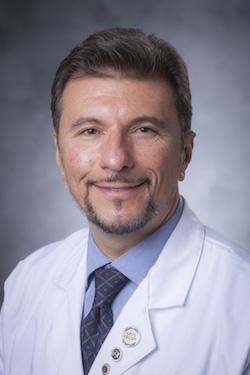
As the niche field of gene augmentation therapy for inherited retinal diseases (IRDs) grows in clinical interest, Duke is participating in the research and testing of the latest, more targeted approaches for treating inherited retinal degenerations and dystrophies. These progressive, blindness-inducing, difficult-to-treat conditions include retinitis pigmentosa, Stargardt disease, cone- and cone-rod dystrophy, Usher syndrome, choroideremia, retinoschisis, achromatopsia, and related conditions.
In this Q&A, Alessandro Iannaccone, MD, MS, FARVO, medical retinal specialist and director of the Duke Center for Retinal Degenerations & Ophthalmic Genetic Diseases, discusses some newer IRD treatment approaches and some limitations he and his team are working to address in the field. He also highlights some of these approaches and ongoing treatment trials in a July 2019 article published in Retina Today.
What new treatments on the horizon do you believe could create the greatest impact for patients with IRDs?
The big race is to find modified viruses that we can inject intravitreally that actually penetrate through the retina from the inside out instead of from the outside in without needing to do a subretinal surgical procedure. One company claims to have identified viruses that penetrate much better than traditional methods, and if that’s true, we may have found the Holy Grail for gene therapy. The alternative is to use a thin transvitreal cannula to do a subretinal injection that does not require vitrectomy.
The other route is the suprachoroidal approach, which involves a device that curves around the walls at the back of the eye and releases medication under the retina through a built-in needle; this could help extend the area that we can reach at the back of the eye. This approach could possibly be adjusted to gene therapy delivery or other kinds of treatments. Lastly, there may be also ways to facilitate the penetration of these modified viruses through the retina by applying special electrical fields to the eye.
What are the limitations of the retinal approach to gene therapy for IRDs?
With the approach we have right now, we can only treat a relatively small part of the retina. We don't know what the level expression of the gene there is going to be or exactly what the level of integration of the genetic material is going to be per cell, so there is a lot of potential heterogeneity. We cannot presently guarantee that the modified virus capsids that target specific genes and mutations transfect into all of the cells, nor that they only go to the cells we want, so there is risk for dispersion in the treatment.
Another impediment is that some genes are too big to fit into these viral capsids. The analogy I use with my patients is that we're trying to fit two to three weeks’ worth of clothing into a carry-on suitcase, but instead of clothing, it’s genetic material. We also have to take into account the stage of the disease. If the disease is too advanced, we may not be able to accomplish much with gene therapy as normally intended (i.e., to replace a missing gene function or block an abnormal one).
What is the biggest challenge with respect to gene-specific therapies?
Many new treatments now aim at targeting not just specific genes but specific mutations or type thereof. There are over 350 genes responsible for the various types of IRDs. Since gene-specific therapies need to target the individual gene, that in itself is a significant level of heterogeneity, and it will take years to develop and test in trials gene therapies for each of them.
Now, imagine that every gene usually has a minimum of 300 or so base pairs that could be mutated, so we can end up needing at least 100 different potential therapies per gene if we target specific mutations. If we start developing more targeted, highly specific treatments, we are looking at potentially needing to develop and test in trials as many as 30,000 different treatments. The implementation curve for this type of gene-specific treatment is theoretically ideal, because it’s highly specific, but not feasible in the short to midterm. This means that a large number of patients with rarer mutations may never receive the benefit of a gene-specific treatment unless the whole gene is replaced/corrected. Either way, continuing to explore and develop alternatives to gene-specific therapies remains essential.
What is Duke doing to improve patient care and expand IRD research?
In the Duke Center for Retinal Degenerations & Ophthalmic Genetic Diseases, we are hiring a genetic counselor who will coordinate the testing of patients and schedule visits on short notice to interpret results, which is deeply important to patients, and we are hiring a research assistant who will help manage the complex and highly diversified portfolio of clinical studies and trials that we have to run. We are also offering a new fellowship program to train the next generation of IRD specialists and help move ongoing gene/disease-specific and gene/disease-independent treatment trials forward.
Article originally appeared in Clinical Practice Today